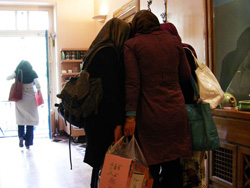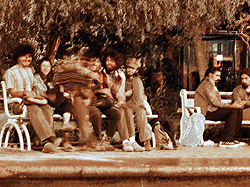An American in Tehran
My decision to visit was not impulsive, in fact, there is a story behind it. In New York City, on the 5th Anniversary of September 11, I was just beginning a performance piece at the foot of the former World Trade Center. It was a very simple concept-- in the midst of the clashes between anti-war protesters and staunch republicans, mourners and people rallying against "Islamofascism"-- I was going to hold a sign that read "Unconditional Love is Global Security". Armed with my sign and a video camera, I would stand quietly and only speak when spoken to. Within a few minutes, a couple passed by, continued on for about 50 meters, then turned sharply around and came back toward me with purpose. "I wish you were in Tehran, with your sign", the woman says, "If that's all it takes, take it to them". She continues to invite me, challenge me rather, to go to Tehran and come back and tell her what sort of love I felt while there. "You just believe in this fairytale that is not going to happen" her husband explains to me "There'll always be evilness in this world".
After saving some cash, being given some private donations-- then waiting for months to find out whether I was approved for a visa-- I took up this woman's challenge and was set to make an appearance in Tehran. My head was filled with unknowns. This was not your standard trip to Paris or Rio-- this was the Islamic Republic of Iran-- full of women in chadors, 'death to america' and did I mention 'death to america'?
I truly had a full-spectrum experience of Tehran, albeit brief. People were quite excited to hear that I was American and were quick to acknowledge their love for American people. I drank tea with a mullah (the cultural director of Hazrat-e-Abdul Azim-e Holy Shrine) while covered in a chador. I drank whiskey with a former revolutionary, jailed and tortured by the Shah, who praised George Bush and his removal of Saddam Hussein, while trying to constantly convince me that a Shiite government is illegitimate by its own rules. I was escorted to top of one of the prayer towers at Imam Khomeini's Shrine, clutching a gifted copy of Khomeini's "Islamic Government" and later sipped on vodka punch at a house party-- while gorgeous Iranian women in low cut tops mixed with men they weren't married to. I toured private galleries where young, hip twentysomethings met to screen Sigur Ros documentaries and discuss Jeff Koons and Matthew Barney. I even had a chance to take my "Unconditional Love" sign and hold it up at the Azadi Monument-- the guys running the museum underneath were quite friendly, and loved the sign after a female associate came out to translate for them.
Consider a visit to Iran. Pick up a Lonely Planet and read a bit about what its like to travel through the country. -- B.O. from Boston, USA |
 In October 2008, I headed to Iran to experience the over-politicized country firsthand. As an American, I knew almost nothing about its daily life, as an artist, I knew nothing about its contemporary art scene, and as a lady, I knew nothing about its very gender-specific rules. In a short two weeks staying in the center of the city, I found that even as mainstream talking heads denounce Ahmadinejad and Iran's nuclear ambitions while proclaiming the nation a part of the Axis of Evil, it's true indeed... life goes on in Tehran.
In October 2008, I headed to Iran to experience the over-politicized country firsthand. As an American, I knew almost nothing about its daily life, as an artist, I knew nothing about its contemporary art scene, and as a lady, I knew nothing about its very gender-specific rules. In a short two weeks staying in the center of the city, I found that even as mainstream talking heads denounce Ahmadinejad and Iran's nuclear ambitions while proclaiming the nation a part of the Axis of Evil, it's true indeed... life goes on in Tehran. There are countless reasons why this couple should be studied by social scientists in the years to come. Most notably, the fact that Iran had nothing to do with the 9/11 attacks and that their stereotypical view of the Islamic Middle East fit, well, a stereotypical view of Judeo-Christian America. But for the sake of this article, let's focus on the fact that this woman considered a trip to Tehran a death sentence and an experience void of love. I didn't want to take her word for it.
There are countless reasons why this couple should be studied by social scientists in the years to come. Most notably, the fact that Iran had nothing to do with the 9/11 attacks and that their stereotypical view of the Islamic Middle East fit, well, a stereotypical view of Judeo-Christian America. But for the sake of this article, let's focus on the fact that this woman considered a trip to Tehran a death sentence and an experience void of love. I didn't want to take her word for it. As it turns out, I was indeed impressed by my experience. I had taken everything I'd read at face-value, and was shocked that there was no search and seizure for 'un-islamic material' at the airport-- my laptop and camera were safe. I came covered in black, while the woman next to me casually pulled on her multi-colored scarf while disembarking the plane. I avoided making eye-contact with our guide, while he was clearly interested in what I what I had to say. As the days progressed, my adherence to the customs I'd read about would casually fade. Only on paper or to the truly religious, it seemed, were these rules applicable. By the end of my trip, I sported an electric blue scarf and spoke to men with ease.
As it turns out, I was indeed impressed by my experience. I had taken everything I'd read at face-value, and was shocked that there was no search and seizure for 'un-islamic material' at the airport-- my laptop and camera were safe. I came covered in black, while the woman next to me casually pulled on her multi-colored scarf while disembarking the plane. I avoided making eye-contact with our guide, while he was clearly interested in what I what I had to say. As the days progressed, my adherence to the customs I'd read about would casually fade. Only on paper or to the truly religious, it seemed, were these rules applicable. By the end of my trip, I sported an electric blue scarf and spoke to men with ease. If you're here-- if you've navigated to Life Goes on in Tehran-- you are likely not surprised, that I found a culture far more multi-dimensional that Americans are led to believe. One months entry from this blog would likely provide more insight to Iran than any American media source. Don't get me wrong, I'm not trying to convince anyone that Iran is all chocolate and rainbows, but it's clear that the image presented by Western media is largely inaccurate and all of us can help repaint that picture.
If you're here-- if you've navigated to Life Goes on in Tehran-- you are likely not surprised, that I found a culture far more multi-dimensional that Americans are led to believe. One months entry from this blog would likely provide more insight to Iran than any American media source. Don't get me wrong, I'm not trying to convince anyone that Iran is all chocolate and rainbows, but it's clear that the image presented by Western media is largely inaccurate and all of us can help repaint that picture.